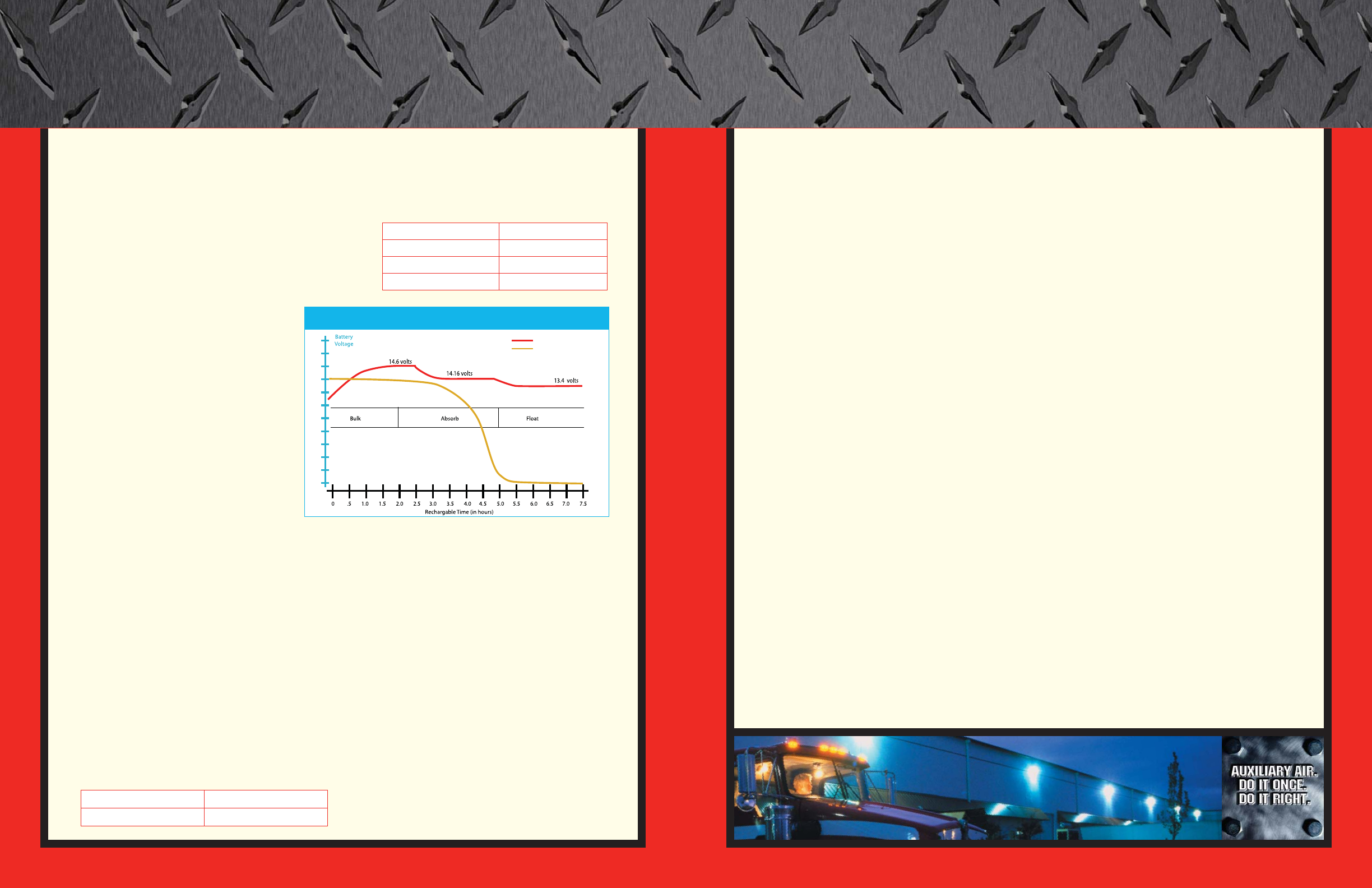
Alternator/Regulator
Most trucks have a standard 135-amp alternator with internal regulator, which is adequate for keeping the batteries
charged under normal conditions. This is not sufficient, however, for the heavier charging requirements for a bat-
tery-powered air conditioning system. Dometic specifies a high-
output alternator with an external regulator. The regulator acts
as a three-stage battery charger that charges and protects the
batteries through numerous discharge cycles.These guidelines
apply when sizing the alternator:
Inverter
The inverter takes the 12 Volt DC output from
the batteries and changes it to 115 Volt AC
current, which is fed to the air conditioner and
other AC-powered devices. We have tested and
evaluated dozens of different inverters, and we
have selected a 2,000 Watt unit with a modified
sine-wave (MSW) output. This unit includes a
115 Volt pass-through circuit and built-in 50 amp
charger to permit you to run the air conditioner
and recharge the batteries from shorepower
when available. It is also offered as an inverter-
only model without the charger.We developed this inverter in conjunction with a company with wide experience in
this technology, and we have confidence in its ability to start and run our air conditioning systems. Remember,
whenever the air conditioning system cycles on there is a momentary heavy load that the inverter must accept and
hold until the compressor gets past its starting requirement. It’s only a few milliseconds, but it’s very important.
We do not recommend running our air conditioning systems with any inverter not previously tested and approved
by Dometic engineering.
Shorepower
Although there are relatively few shorepower hookups available at truck stops, rest stops and terminals, these will
become more readily available in the future.
TMC recommends a minimum of one 20-amp circuit for shorepower connections. You should use any heavy-duty
power cord with a standard three-prong plug. Remember that there will be a voltage drop across the cord, so you
should use the minimum length necessary to reach your outside power source.
INSTALLING, OPERATING AND
MAINTAINING THE SYSTEM
Installation
Dometic will provide detailed installation instructions with your system. You should make sure you understand
these instructions and follow them completely.
Controls
The Dometic auxiliary air system comes with a standard digital thermostat/display unit. Operation is intuitive and
easy, with up and down arrows to adjust the setpoint and fan speed.
Optimizing Performance
To improve the air conditioner’s performance on a hot day, you can reduce the heat load by parking in a shaded
area, covering the windows with reflective shades to block out direct sunlight and pulling the curtain between the
sleeper and cab. Make sure windows and doors are tightly closed, and turn off any other heat-producing appliances.
Operation and Maintenance
Make sure you inspect the batteries frequently. Check for solid electrical connections. Be sure the cable connec-
tions are good with no corrosion showing. Check for chafing and moisture.
You should inspect and clean the air filter regularly to ensure good airflow across the evaporator coils. You will find
the filter in the return air path, either directly behind the grill or in front of the evaporator coil.
Make sure you do not block the airflow between the return air grill and evaporator coil with pillows, blankets,
papers or other objects.
Check the condensate drain often to make sure water is draining properly. Make sure the drain fittings do not get
clogged.
If you have a split system with external condensing unit, make sure you inspect and clean any debris from the con-
denser coil to ensure good air flow.
Dometic’s auxiliary air systems, both self-contained and split, are designed so that you should never need recharge
the refrigerant loop under normal circumstances. If the refrigerant level ever needs to be adjusted, federal law
requires that it must be done by an EPA-licensed HVAC technician with the proper tools to avoid accidental dis-
charge of any refrigerant gas into the air.
Occasionally check for chafe on outside wires and refrigerant lines (split systems).
Number of batteries Alternator size
6 or less 185 amps
7 to 9 270 amps
10 or more 320 amps
12 gauge cord Up to 25 ft.
10 gauge cord Up to 50 ft.
Advanced alternator
Standard alternator
17
16
15
14
13
12
11
10
9
8
7
6
TYPICAL CHARGING CURVE FOR LEECE-NEVILLE
HIGH-CAPACITY ALTERNATOR WITH AGM BATTERIES










